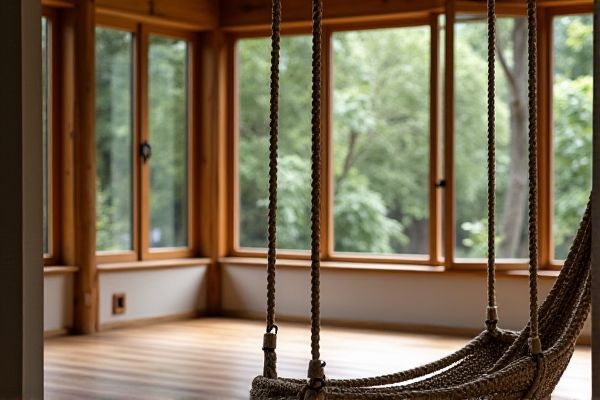
Wooden swings offer a sturdy and classic feel with a solid seat that ensures comfort and durability, while rope swings provide a flexible, lightweight design that can be easily customized to fit various outdoor settings. Discover which swing suits Your backyard best by exploring the detailed comparison in the rest of the article.
Table of Comparison
| Feature | Wooden Swing | Rope Swing |
|---|---|---|
| Material | Durable hardwood or softwood | Strong natural or synthetic ropes |
| Comfort | Solid, rigid seating | Flexible, adjustable seating |
| Durability | Long-lasting, weather-resistant | Susceptible to wear, needs frequent checks |
| Installation | Requires secure mounting, typically more complex | Easy to hang on trees or beams |
| Safety | Stable, less movement risk | Higher swing motion risk, needs supervision |
| Maintenance | Periodic sealing or painting | Rope replacement and inspection |
| Weight Capacity | High, supports heavier loads | Varies by rope strength, generally moderate |
| Cost | Moderate to high | Low to moderate |
Overview: Wooden Swings vs Rope Swings
Wooden swings offer sturdy construction and classic appeal, often crafted from durable hardwoods that provide stability and longevity for outdoor use. Rope swings feature flexible, lightweight designs that allow for greater movement and versatility, making them ideal for natural settings like trees or playgrounds. When choosing between the two, consider your outdoor space, safety preferences, and desired swinging experience to ensure your swing meets your needs.
Material Comparison: Wood and Rope
Wooden swings offer sturdy support and natural durability, making them ideal for long-term outdoor use, while rope swings provide flexibility and a lightweight design for versatile placement. Wood materials typically resist wear and weather better, offering a solid feel that enhances safety during play. Your choice depends on whether you prioritize the robust structure of wood or the adaptable, easy-to-install nature of rope.
Durability and Longevity
Wooden swings offer superior durability due to their solid construction and resistance to weathering when treated properly, often lasting several years with minimal maintenance. Rope swings, while flexible and lightweight, can deteriorate faster under outdoor conditions, especially if exposed to moisture, UV rays, and friction, leading to fraying or weakening over time. Choosing treated hardwood for wooden swings and UV-resistant, marine-grade ropes can significantly enhance their longevity in outdoor environments.
Safety Considerations
Wooden swings offer sturdy construction and durability but require regular inspection for splinters, cracks, and secure mounting to ensure safety. Rope swings provide flexibility and ease of installation yet must use high-quality, weather-resistant ropes and secure knots to prevent accidents. Prioritize your child's safety by regularly checking the condition of materials and proper installation regardless of the swing type.
Installation and Maintenance
Wooden swings require sturdy support structures and careful anchoring to prevent wood decay and ensure safety during installation. Rope swings offer easier setup with fewer tools, relying on strong, durable ropes tied securely to a stable branch or beam. Maintenance of wooden swings involves periodic sealing and checking for splinters, while rope swings need regular inspection for frayed fibers and tightening to maintain integrity.
Comfort and User Experience
Wooden swings offer a sturdier and more stable seating surface, enhancing overall comfort during use, while rope swings provide a flexible and dynamic experience that can be thrilling but less consistent in support. The smooth, solid texture of wood prevents excessive movement, reducing strain and allowing You to enjoy longer, more relaxing swings. Rope swings may require adjustments to improve comfort, as the softness and movement can cause discomfort during extended use.
Aesthetic Appeal and Design
Wooden swings offer a classic, rustic aesthetic that naturally blends with garden or backyard settings, showcasing natural wood grain and warm tones that enhance outdoor decor. Rope swings, on the other hand, provide a playful and minimalist design with versatile installation options, often evoking a nostalgic, whimsical charm ideal for casual, relaxed spaces. Your choice depends on whether you prefer the sturdy elegance of wood or the breezy simplicity of rope for your outdoor ambiance.
Cost and Budget Factors
Wooden swings typically have higher upfront costs due to material and craftsmanship, but offer durability and long-term value. Rope swings are generally budget-friendly with lower initial expenses but may require frequent replacements or maintenance. Considering installation, weather exposure, and safety features impacts the overall budget for both types of swings.
Best Use Cases for Each Type
Wooden swings excel in providing sturdy support and classic aesthetics, making them ideal for backyard play areas or garden relaxation spots where durability and comfort matter most. Rope swings offer greater flexibility and excitement, well-suited for adventurous outdoor spaces like parks or wooded areas where dynamic movement and natural integration enhance the experience. Your choice depends on whether you prioritize stability and timeless design with wooden swings or versatility and thrill with rope swings.
Final Verdict: Choosing the Right Swing
Wooden swings provide sturdy construction and classic aesthetics, offering durability and a stable seating experience ideal for prolonged use. Rope swings deliver flexibility and a playful feel, perfect for quick setups and varied motion but may require more maintenance. Your decision depends on whether you prioritize solid craftsmanship and longevity or adaptability and dynamic movement.
 homyna.com
homyna.com